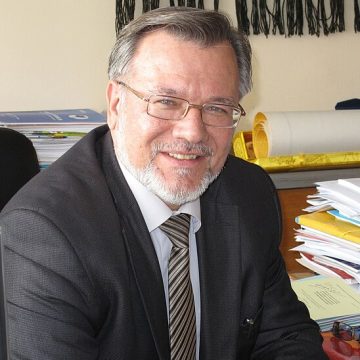The 19th Congress of the Communist Party of China is an intermediate stage in the formation of China as a leader of the new world order, says Sergey Luzyanin, Director of the Institute of Far Eastern Studies, Russian Academy of Sciences.
Soft Leadership
Documents of the 19th Congress of the Communist Party of China (CPC) set a tentative timeframe for the transformation of China into a great power by 2050. Most likely, this is underestimation. In fact, China has already entered grand geopolitics and in 10-15 years (if there is no force majeure in the world or in China itself) it will become the absolute leader of the world community. By promoting the Belt and Road project in all directions (economic, transport, investment, etc.), the Chinese leadership, in fact, synthesizes geo-economics and geopolitics. Refusing to call the initiative a geopolitical project, it combined the land and sea geopolitics of rising China into a single track.
Such a synthesis enables China to manoeuvre in a wide geographical range – from the Eurasian space to the southern seas and the Northern Sea Route. China is unlikely to radical transform the world order that has been created. But at the same time, it gradually and gently updates the global governance system – the IMF, the WTO, advances the BRICS, expands the SCO together with the Russia, etc.
Socialism with Chinese characteristics
The promotion of socialism with Chinese characteristics means the simultaneous advancement of two formally contradictory trends:
1) strengthening and expansion of the liberal economic sector, partial reduction of the public (socialist) sector;
2) tightening of the CPC vertical of power and personal authority of Xi Jinping.
At the same time, it contains almost no contradiction for the ordinary Chinese: the country is economically successful, the living standards are gradually increasing, society is politically stable and the hierarchy, which is understandable to millions of Chinese, comes from the traditional Confucian customs and values. In this context, Xi Jinping skilfully adds the traditional (historical) motivation – desire of the Chinese nation to revive the power and grandeur of the ancient Chinese civilization – to the ideology of “socialism with Chinese characteristics”. One can say that Chairman Xi incorporated a living Chinese history, understandable and close to the ordinary man, into the dry communist ideologemes.
Xi Jinping and the “Chinese dream”
Undoubtedly, the Congress is a staging point of consolidation of Xi Jinping’s personal power. The principal thing in this process is that the Chinese party leadership introduced his name into the CPC Constitution, placing him on a par with great predecessors – Mao Zedong and Deng Xiaoping. Together with the Belt and Road initiative, his name is associated with the idea of the “Chinese dream”, the “new state governance” concept, including the most severe anti-corruption struggle he launched in China.
To date, Chairman Xi Jinping is the third most important theorist and practitioner of the “Socialism with Chinese characteristics” concept. The novelty of his approaches lies in the fact that he brought classical geopolitics to the mass Chinese consciousness – the desire to revive the Chinese nation and its power. As to the domestic policy, he deliberately promotes the idea of a renovated, “pure” China, without thieves and bribe-takers through a brutal anti-corruption struggle. It is characteristic that the bulk of those who came under court are small, medium and big state and party officials (2,400 thousand people), but not the representatives of business. Such a struggle is what the people like.
What matters most in terms of Xi Jinping’s personal power is the 20th Congress of the Party in 2022, when he must traditionally hand over the reins of power to the next leader.
Changing the economic growth model
During the formation of the great power contours, the Chinese leadership came to the conclusion that it was necessary to change the model of economic growth – transition to an innovative model, use of domestic resources, including technological growth. This transition, as noted at the Congress, is just at the beginning, and inevitably causes a decline in the annual GDP growth rate to 7.2 – 6.7%. Here, we see a fairly clear trend toward the strengthening of the “people’s economy” – that is, private-public, liberal sector, strengthening of the social component (implementation of the Xiaokang doctrine).
The Chinese leaders in charge of the economic bloc came to the conclusion that there was overproduction of certain types of products. In particular, there is a surplus of 100 million tons of steel, 400 million tons of coal, etc. Partial reduction in these sectors and the strengthening of innovative production on a market basis are being planned. In the future, the public sector will continue to play its role. At the same time, the reform of the banking, energy, agricultural and other sectors is on the agenda.
The North Korea problem
The North Korea problem is one of the most difficult ones for Beijing. In fact, over the past 10 years, the PRC has been trying to find some ways of influence first on Kim Jong Il, and after his death, on his son Kim Jong-un, the current leader of the DPRK. There is a myth about the hidden influence of Beijing on Pyongyang. In fact, this resource vanished long ago.
At the same time, any real (nuclear or non-nuclear) conflict on the Korean peninsula is deadly dangerous for the People’s Republic of China from the military-political, migration, and economic points of view. The Congress did not say what to do and how to deal with the DPRK. While the tactical steps of Beijing and Moscow mean the support of the sanctions policy of the UN Security Council, the sanctions against the DPRK have exhausted themselves.










